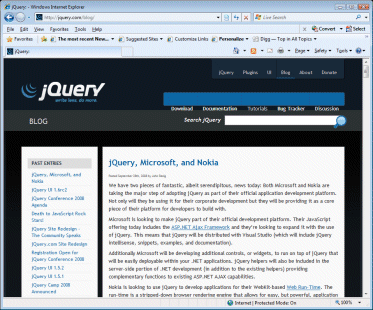Following Scott Guthrie’s remarkable announcement about jQuery getting integrated into Visual Studio and ASP.NET, I took a look at the jQuery site and blog. I mix and match with my browser usage, and on this occasion was using IE7. The page was badly scrambled:

It is meant to look like this, as it does in IE8:

I tried the site with IE7 on another machine and it was fine, so this is not a problem with all IE7 installations, though it is fully repeatable on this particular box. I don’t know what is causing the issue.
Still, it reminded me of a significant change on the Web, which is that IE is no longer the safest choice if you are pragmatic and simply want sites to look right. In fact, there are more occasions when I have to close IE and use Firefox or Chrome to view a site properly, than the other way round.
I also notice a sharp decline in IE usage in my browser stats. 80% of visitors run Windows, but only 40% use IE in this month’s figures. A year ago that was 82% and 58%.
My stats are not representative of the web as a whole, which gives IE a larger share, but everyone seems to be reporting a decline. IE8 may slow the decline, but I doubt it will reverse it.
It may seem odd, but I know of some companies that have only very recently upgraded all browsers to IE 7. None of the users within that company have the technical savvy or interest to use an alternative browser. These users probably represent the biggest ‘problem’. Do you agree?
Worked ok on my IE7. All that was missing were curved corners on the white areas and there is a single white pixel underneath the magnifying glass which is not there on Chrome or Firefox.
Interestingly Chrome has no lines between the Past Entries until you hover whereas IE7 and Firefox have these. Seems every browser is different and there is no ‘standard’.
I am liking Chrome (on a newish machine) but it has several missing features, the one I miss most is the ability to email a link directly.
Oops, Chrome does have lines (I was viewing it on a different monitor) but all three browsers have different spacings for the Past Entries with IE7 being the widest and Chrome the narrowest, so my point stands I think.
First thing to check is whether IE sends different user-agent strings from two machines.
We experienced similar problem, it turned out that on one machine there was some IE add-on installed, which has changed some registry setting, which caused IE to send unusual user-agent string which fooled browser detection logic on the web site, resulting in botched layout.
I am not very familiar with site development. But from what I understand, IE still seems to be used a “point of reference”, when it comes to viewing a web site. Which means, a site will be developed to perform/load/appear optimally in IE. And after that, browser-compatibility is checked and corrections are made.
Ironically, IE does not follow W3C standards to the T. Which means, site development and checking should be done first on the alternative browsers which conform to these standards. Rather than the other way round.
Internet Explorer? what the heck’s that? lol…. Firefox is the only way to fly…..
Great! The sooner IE dies means the easier to develop websites, and not have to hack them to work in IE. I wish IE6 was dead already.. unfortunately this probably won’t happen for many years..